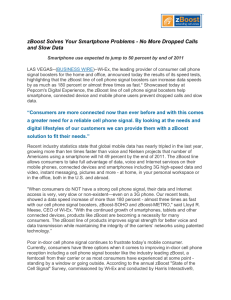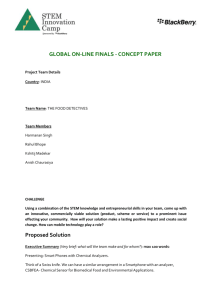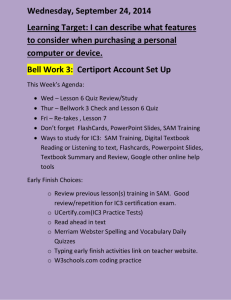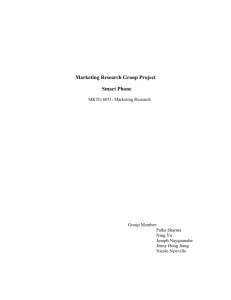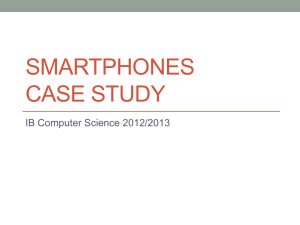Institute for Social and Economic Research
advertisement
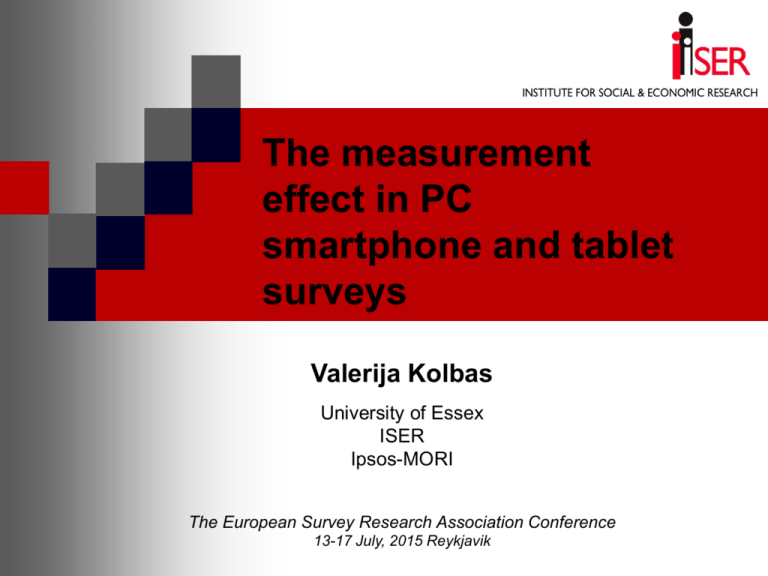
The measurement effect in PC smartphone and tablet surveys Valerija Kolbas University of Essex ISER Ipsos-MORI The European Survey Research Association Conference 13-17 July, 2015 Reykjavik Background and motivation Limiting surveys to the PC mode affects the size and representativeness of the sample PC, smartphones, tablets differ in: size of the screen input method speed of connection processing power Different effect on the measurement error Background and motivation Smartphone more break-offs longer completion time More straightlining Tablet Less primacy effect Less straightlining Less or comparable completion time Other indicators question order effect primacy effects open-ended answers response distribution Mixed results … but non-optimized mobile design affects completion rates, satisfaction with the survey Background and motivation PC and mobile response distributions are equally affected by response formats Drop-boxes –preference for first options Grids – preference for visible options, straightlining - no conclusive evidence which format is better for mobiles Research Question How mode of administration and response format affect survey responses Indicators of measurement error: overall satisfaction rates straightlining response distribution length of open-end questions Survey and Questionnaire design National Satisfaction Survey 2014 Administered to final year higher education students in UK 22 core questions using a 5-point Likert scale 2 open-end questions Mixed-mode: self-selected mail, phone, web 5 response formats – randomly allocated Sample composition Radio-button PC N=5529 Web Survey Sample N=9276 Radio-button Smartphone N=3196 Drop-box (+) Drop-box (-) Tablet N=551 Drop-box (0) Drop-box () Screenshots: response design • Once clicked a list with options appears on a separate screen. • Responses always in the same order Screenshots: response design • Requires vertical scrolling. • All questions are visible on the screen. • Requires horizontal scrolling . • Portrait or landscape viewing. Measurement Effect between PC smartphone tablet responses Comparisons made across all three modes, but within one radio-button response format 10 Measurement Effect between PC smartphone tablet MANOVA to test for differences F=2.3, p<.05 F p PC smartphone tablet Straightlining 3.9 <.05 6.9% 10.3% 6.4% Modal responses <1 >.05 Mean values 2.7 .07 4.1 4.1 4 Positive feedback 1.3 >.05 195 180 191 Negative feedback 1 >.05 257 240 243 ‘Mostly Agree’ ‘Definitely Agree’ & ‘Mostly Agree’ ‘Mostly Agree’ ME between PC, smartphone, tablet summary Smartphone straightlining significantly higher Tablet straightlining rate the lowest Signs of the visibility effect for smartphone Other quality indicators comparable between all three modes Measurement Error between different response designs presented on a smartphone and a tablet Comparisons made across five survey response formats within smartphone and tablet modes 13 MANOVA test of differences F=2.7, p<.05 F p device 2.7 <.05 format 1.7 <.05 interaction 1.3 .18 Both device and format affected data quality Responses in Drop-box with a positive initial option 70.00% Smartphones 60.00% higher selection of initially suggested response. less moderately positive responses 11.1% straightliners Mean 4.3 50.00% 40.00% 30.00% Tablets 20.00% 10.00% 0.00% Def.Agree Mostly Agree Neither smartphone Mostly Disagree tablet Def. Disagree Similar selection of extreme and moderately positive responses More negative responses 5.6% straightliners Mean 4.1 Responses in Drop-box with a negative initial option 50.00% Smartphones 45.00% 40.00% 35.00% 30.00% More extreme negative responses Less positive responses 8.4% straightliners Mean 4 25.00% 20.00% Tablets 15.00% 10.00% 5.00% 0.00% Def.Agree Mostly Agree Neither smartphone Mostly Disagree tablet Def. Disagree More positive responses Extremely low ‘Definitely Disagree’ frequency 2.5% straightliners Mean 4.1 Responses in Drop-box with a middle initial option 45.00% Smartphone and Tablet 40.00% Comparable results 35.00% Weak evidence of selecting the middle option Most frequent ‘Mostly Agree/Disagree’ selection across formats 6.5% and 6.1% of straightliners Mean 4 an 3.9 30.00% 25.00% 20.00% 15.00% 10.00% 5.00% 0.00% Def.Agree Mostly Agree Neither smartphone Mostly Disagree tablet Def. Disagree ME indicators summary Smartphone – answers affected by response formats. Initially suggested response is selected more often Tablet – no strong effect of response formats. No significant differences in the length of open answers between formats. Potential Limitations No reverse-coding Similar question wording Not counterbalanced question or response order Instructions universal for each response format Self selected device condition Survey sample: highly educated, IT literate, similar age, highly motivated Thank You vkolba@essex.ac.uk
